Book Review – The Light of Paris
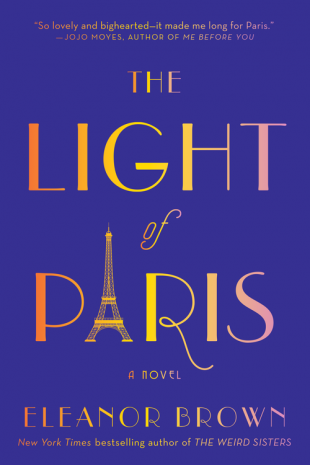 The Light of Paris by Eleanor Brown
The Light of Paris by Eleanor Brown 
Published by G.P. Putnam's Sons on July 12th 2016
Genres: Historical Fiction
Pages: 308
Goodreads
Goodreads Synopsis:
The miraculous new novel from New York Times–bestselling author Eleanor Brown, whose debut, The Weird Sisters, was a sensation beloved by critics and readers alike.
Madeleine is trapped—by her family’s expectations, by her controlling husband, and by her own fears—in an unhappy marriage and a life she never wanted. From the outside, it looks like she has everything, but on the inside, she fears she has nothing that matters. In Madeleine’s memories, her grandmother Margie is the kind of woman she should have been—elegant, reserved, perfect. But when Madeleine finds a diary detailing Margie’s bold, romantic trip to Jazz Age Paris, she meets the grandmother she never knew: a dreamer who defied her strict, staid family and spent an exhilarating summer writing in cafés, living on her own, and falling for a charismatic artist. Despite her unhappiness, when Madeleine’s marriage is threatened, she panics, escaping to her hometown and staying with her critical, disapproving mother. In that unlikely place, shaken by the revelation of a long-hidden family secret and inspired by her grandmother’s bravery, Madeleine creates her own Parisian summer—reconnecting to her love of painting, cultivating a vibrant circle of creative friends, and finding a kindred spirit in a down-to-earth chef who reminds her to feed both her body and her heart.
Margie and Madeleine’s stories intertwine to explore the joys and risks of living life on our own terms, of defying the rules that hold us back from our dreams, and of becoming the people we are meant to be.
My Review:
I was unfamiliar with Eleanor Brown prior to reading The Light of Paris and have to confess the main reasons I picked it up were 1) I had just visited Paris last summer and wanted to recreate the magic I experienced during my time there, and 2) that gorgeous purple cover kept catching my eye every time I saw it displayed at the bookstore and in the library.
I’m so glad that I picked up The Light of Paris though because it introduced me to a wonderful writer in Eleanor Brown and it most definitely made me fall in love with Paris all over again.
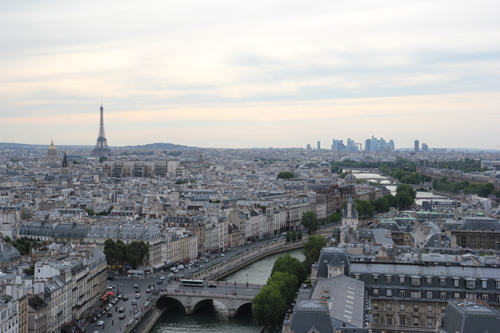
View of Paris from the bell tower at Notre Dame Cathedral – photo taken by me.
So what did I love about The Light of Paris?
Dual Narrative Point of View and Time Jumps:
I’ve always enjoyed novels where a historical tale is framed within a contemporary one and The Light of Paris fits that bill for me. Eleanor Brown has beautifully woven together the stories of Madeleine in 1999 and her grandmother Margie in 1924. Aside from their biological relationship, their stories, although being told 75 years apart, are tied together by another common thread as both women are dealing with the same basic struggle – how to live their own lives and pursue their passions when societal and family expectations dictate they should do otherwise.
Brown begins with Madeleine’s journey. Madeleine is dealing with an overly controlling husband and, consequently, an unhappy marriage. When she learns that her mother is selling her home, Madeleine uses this as an excuse to get away from her husband for a while. It is while she is at her mother’s home that Madeleine discovers some old journals in storage and first learns about Margie and her trip to Paris. The rest of the novel alternates between Madeleine in 1999 and Margie in 1924 as they each try to find their own way and live life on their own terms. I have read books where the time jumps and switch in point of view can be confusing and doesn’t work well, but Brown does a lovely job and the story flows smoothly and naturally between Madeleine to Margie from start to finish.
Setting:
I also love the way Brown captures the sights, sounds, and spirit of Paris as she describes Margie’s time there. If you’ve never been to Paris before, by the time you’re finished reading, you’ll have a first class case of wanderlust and will want to pack your suitcase and head there for a romantic adventure of your own. And if you’ve been to Paris before, Brown will make you fall in love with the City of Lights all over again. Brown also paints a truly vivid portrait of 1920’s Jazz Age Paris — so much so, in fact, that as I was reading, I half expected Ernest Hemingway to come strolling through the doors of one of the cafes that Margie frequented.
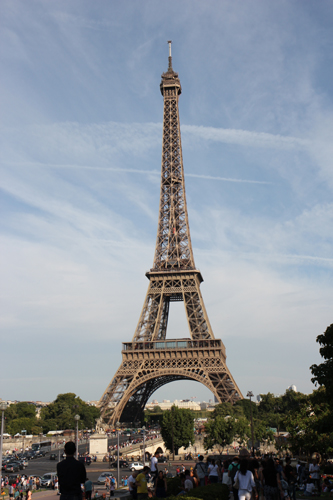
The Eiffel Tower in Paris. Photo taken by me.
Main Characters You Can Root For:
Margie’s story was, by far, the more interesting of the two narratives for me. Margie’s dilemma is that while her parents expect to her marry and settle down with a suitable husband as soon as she is finished with her education, what she really wants to do is follow her passion, which is writing, and become an author. It was spectacular watching her go from being this little cotillion-attending, debutante girl doing everything that was expected of her to suddenly rejecting the suitor her parents have chosen for her, then further rebelling against them by refusing to return home from a trip to Paris and instead living there on her own for months. She was really a woman ahead of her time in that sense and I cheered her on every step of the way. Watching her blossom into her own person as she sat in cafes indulging in her writing habit and then finding love on her own terms was so inspirational. I loved Margie’s story so much that if that had been the sole focus of the novel, this probably would have been a 5 star read for me.
Where Margie’s story was inspiring, however, Madeleine’s story was often frustrating for me. Similar to Margie and her passion for writing, Madeleine has a passion for art and actually wanted to go to school to study to become an artist. Instead of following her heart though, Madeleine instead lets her family convince her that being an artist isn’t a viable career and that she should study something more practical like Marketing, and then find herself a good husband. I loved Madeleine and wanted her to be happy, but it blew my mind how much she let her mother, in particular, dictate how she lived her life. As I watched her mope and lament this miserable marriage she’s supposedly trapped in, all I kept thinking was ‘Why did you marry Phillip in the first place? He’s a controlling ass. Why would you let anyone — your husband or your mother — convince you that you shouldn’t pursue your love of art? It’s 1999 and you are a modern woman so start acting like one!’ It made no sense to me that Madeleine needed to read about her grandmother’s rebellious and romantic time in Paris to come to the conclusion that perhaps it was time to kick Phillip to the curb and try something different. I actually think if Margie had still been alive in 1999, she probably would have wanted to give Madeleine a kick in the pants and tell her life is too short not to do what makes you happy.
Likeable Secondary Characters:
I guess it’s a quirk with me but I have to have a likeable secondary cast of characters in order to thoroughly enjoy a story and Brown has given me exactly what I need with the characters of Sebastian and Henry. Sebastian is an artist that Margie meets while in Paris, and Henry is a restaurant owner that Madeleine meets while visiting her mother. Both Henry and Sebastian are charming, down to earth, and just delightful characters. I liked the touch of romance that each of the characters brought to the story, and I especially liked the pivotal role each of them plays in helping Margie and Madeleine discover who they are meant to be. In addition to showing her all that Paris has to offer on a social and artistic level, Sebastian is actually the one who convinces Margie she should stay in Paris when the trip with her cousin doesn’t go as planned. He takes her to a place where she can find suitable, affordable housing and that also helps with job placement for Americans. Henry plays a similar role in Madeleine’s journey, first and foremost, by being her friend and being supportive about things that are of interest to her, namely her artistic abilities, which is something her husband never bothered with. Henry also serves as an inspiration to Madeleine because the whole reason he has this restaurant next door to Madeleine’s mother’s house is because he left his job as a chef at a restaurant to follow his dream – that of owning his own restaurant. If he hadn’t followed his own heart, he and Madeleine never would have met. His journey, especially when considered alongside Margie’s brave and adventurous sojourn in Paris, really give Madeleine the push she needs to start re-evaluating the direction her life has taken and to forge a new and more fulfilling path for herself.
Anything I didn’t care for?
Aside from my frustration with Madeleine, I can’t think of anything else that I didn’t enjoy. Margies’s cousin, Evelyn, was a nasty little girl, but that said, I like to have characters that I can actively dislike as well and she definitely falls into that category.
Who would I recommend this book to?
The Light of Paris was a delightful read on many levels so I’d recommend it, first of all, to anyone who enjoys historical fiction with a hint of romance. I’d also recommend it to anyone who wants a taste of the City of Lights and to anyone who likes a story about people finding themselves.
Rating: A strong 4 stars

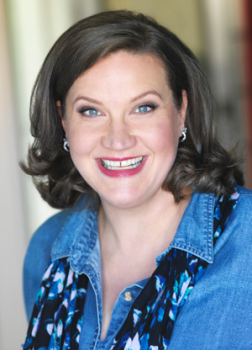
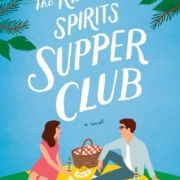


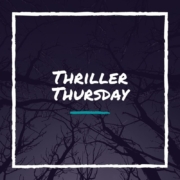
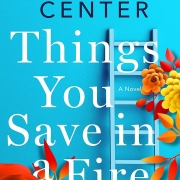



I have this one on my to-read list, and I’m glad to read a good review of it! I love dual timeline novels, and I’m all for anything to do with Paris. I’ve never been there, but I’m kind of obsessed with it!
I love dual timeline novels too and this one was especially cool because of all of the parallels I could see between Margie and Madeleine. Oh, I really hope you get to go to Paris some day. It’s so lovely. The sights, the food, the art, it’s definitely worth being obsessed with 🙂
I enjoye dual time novels. And Paris you say? I think this will be a great read in that case. Great review as well
And 1920’s Paris too so it’s a very exciting time 🙂
I know OF this author, but I haven’t read anything by her yet. This does sound quite good and I’m glad to hear she described Paris so well. I’ve never been but I’d love to visit someday.
This was my first time reading her and I was definitely pleased enough that I want to go back and read The Weird Sisters. I have heard a lot of great things about that book.
Oh my gosh PARIS. I just read a mystery set there, and I totally have a wanderlust for the city right now. I LOVE that this author has captured the city so much and I desperately want to go in summer! This book sounds wonderful AND you are not alone in thinking that a secondary cast of characters adds so much to this!
I think Paris is one of my all time favorite book settings. No matter what the actual subject of the book is, there’s just something about setting it in Paris that adds a little extra magic. I think this one will definitely fuel your wanderlust for the city too. Thanks for much for stopping by The Bookish Libra! 🙂